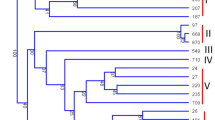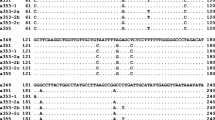Summary
S-alleles of Brassica oleracea were identified using a method which is based on the amplification of S-sequences from genomic DNA, followed by digestion of the PCR products with selected restriction enzymes (PCR-RFLP). A study was made in which the same S-allele was present in the homozygous state in a range of different crop types. This showed that, with minor exceptions, characteristic restriction patterns were obtained, and therefore that it was possible to identify the S-allele. To test whether the method was also suitable for the identification of both the S-alleles present in heterozygotes, a number of S-heterozygotes together with an F2 population were screened. The results showed that the standard method was not very reliable for the identification of both of the S-alleles. This is because firstly, one of the S-alleles may be amplified preferentially, and secondly, the restriction patterns are not unique to a particular combination of S-alleles. Finally, although it is not possible to identify unequivocally both S-alleles of heterozygotes using a standard technique, the procedure can be modified for particular combinations of alleles to enable the identification to be made.
Similar content being viewed by others
References
Brace, J., D.J. Ockendon & G.J. King, 1993. Development of a method for the identification of S alleles in Brassica oleracea based on digestion of PCR-amplified DNA with restriction endonucleases. Sex Plant Reprod. 6: 133–138.
Brace, J., G.J. King & D.J. Ockendon, 1994. A molecular approach to the identification of S-alleles in Brassica oleracea. Sex Plant Reprod. 7: 203–208.
Doyle, J.J. & J.L. Doyle, 1990. Isolation of plant DNA from fresh tissue. Focus 12: 13.
Gaude, T., A. Friry, P. Heizmann, C. Mariac, M. Rougier, I. Fobis & C. Dumas, 1993. Expression of a self-incompatibility gene in a self-compatible line of Brassica oleracea. Plant Cell 5: 75–86.
Kho, Y.O. & J. Baer, 1968. Observing pollen tubes by means of fluorescence. Euphytica 17: 298–302.
Ockendon, D.J., 1980. Distribution of S-alleles and breeding structure of Cape broccoli (Brassica oleracea var. italica). Theor. Appl. Genet. 58: 11–15.
Ockendon, D.J., 1985. Genetics and physiology of self-incompatibility in Brassica. In: I. Sussex, A. Ellingboe, M. Crouch & R. Malmberg (Eds), Plant Cell/Cell Interactions, pp. 1–6. Cold Spring Harbour Lab.
Olerup, O., 1990. HLA class II typing by digestion of PCR-amplified DNA with allele-specific restriction endonucleases will fail to unequivocally identify the genotypes of many homozygous and heterozygous individuals. Tissue Antigens 36: 83–87.
Slocum, M.K., S.S. Figdore, W.C. Kennard, J.Y. Suzuki & T.C. Osborn, 1990. Linkage arrangement of restriction fragment length polymorphism loci in Brassica oleracea. Theor. Appl. Genet. 80: 57–64.
Smith, B.M., J. Blyton-Conway & C. Mee, 1981. Relationships between self-incompatibility and S-allele constitution in inbred lines of Brussels sprouts. Euphytica 32: 187–191.
Trick, M. & P. Heizmann, 1992. Sporophytic self-incompatibility systems: Brassica S-gene family. Int. Rev. Cytol. 140: 485–524.
Author information
Authors and Affiliations
Rights and permissions
About this article
Cite this article
Brace, J., Ryder, C.D. & Ockendon, D.J. Identification of S-alleles in Brassica oleracea . Euphytica 80, 229–234 (1994). https://doi.org/10.1007/BF00039654
Received:
Accepted:
Issue Date:
DOI: https://doi.org/10.1007/BF00039654




